Mazur: Getting To The Bottom Of The Dorak Affair
Dig Of The Century: Getting To The Bottom Of The Dorak Affair
By Suzan Mazur
He's held out longer than Woodward, Bernstein & Deep Throat. But it's time British archaeologist James "Jimmie" Mellaart, now age 80 or so and in his golden years, finally fesses up to the whereabouts of the priceless "Royal Treasure of Dorak," which he first tantalized the world with by publishing drawings of the artifacts in the November 28, 1959 issue of The Illustrated London News, saying the pieces were from a clandestine dig in northwest Turkey. And after which the press clamored to see it. However, fabulous Dorak had by then apparently vanished, along with its owner, Anna Papastrati.
Mellaart said he first met Papastrati, a Greek woman who spoke English with an American accent, on a train bound for the Aegean coast city of Izmir in the summer of 1958. He described her as, "very attractive in a tarty sort of way", and said he was fascinated by an ancient gold bracelet she wore.
Jimmie said Anna told him the bracelet was part of a collection and that she invited him home to see it. After arriving in Izmir -- despite Mellaart's excitement -- they took the long way by ferry to her house across the bay in the Karsiyaka suburbs, where he said he spent the next several days making "rubbings" of the pieces . . .
First, some background on Jimmie Mellaart. And then the evidence that Dorak was a ruse.
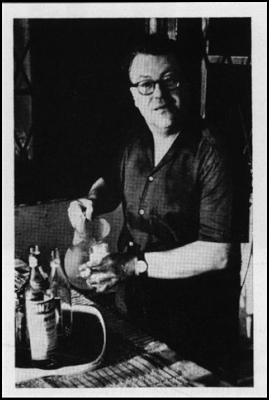
James "Jimmie" Mellaart -- Photo credit: now-defunct Horizon Magazine
In the early 1950s Jimmie Mellaartt was a scholar attached to the British Institute of Achaeology -- Ankara (BIAA). He was born into an art family, and from childhood surrounded himself with books on the ancient world, so that upon arrival in Turkey he was hellbent on uncovering the country's rich cultural prehistory. Mellaart's discoveries in southern Turkey made him famous in archaeology circles: Copper Age Hacilar in 1956, and then in 1958 Catalhoyuk (formerly called Catal Hoyuk and meaning "forked mound"), a Neolithic site dating from 7,500 BC, considered by many to be the world's oldest urban civilization. [Click here: www.catalhoyuk.com http://catal.arch.cam.ac.uk/catal/index.html]
Catalhoyuk's man-made walls revealed murals of what Mellaart interpreted as goddesses giving birth to bulls and other hunt-fertility symbols. The site produced obsidian mirrors and idol figurines believed to be the earliest depictions of the cult of Kybele - Anatolia's mother goddess.
"Catalhoyuk was also a sort of cathedral to the bull and the first evidence we have of the domestication of cattle," writer Michael Rice told me by phone from Britain. Rice, author of The Power of the Bull (Routledge), said that with the discovery of Catalhoyuk - a site thousands of years earlier than the first cities of Mesopotamia - Mellaart transformed our understanding of the origins of civilized society in the ancient Near East.
However, true celebrity for Mellaart came only after publication of his tale of the glitzy treasure of Dorak the following year. He wowed readers by claiming the treasure had been illegally dug up during the Turko-Greek war (1919-1922) from two royal tombs of the Yortans, neighbors of the Trojans.
The significance of this Yortan find was its establishing that a major seafaring nation existed in northwest Anatolia, adjacent to Troy, around the time of the Egyptians. Mellaart said he was able to deduce this from a gold sheet in the collection, which he claimed was once attached to a wooden throne. It was embossed with Egyptian hieroglyphics bearing the name and titles of Pharaoh Sahure (2487-2473 BC) - thus a royal gift from the Egyptians.
And Mellaart said there was a "silver sword of state" as well, decorated with seagoing ships. In other words, the Yortans were no longer merely a collection of villages producing pottery.
 "Certainly
the earliest detailed representation of ocean-going ships
yet known outside Egypt . . . indeed it is in vessels like
these that we can imagine the legendary Argonauts sailing
through the Sea of Marmora, past Dorak, on their way to
Colchis."
"Certainly
the earliest detailed representation of ocean-going ships
yet known outside Egypt . . . indeed it is in vessels like
these that we can imagine the legendary Argonauts sailing
through the Sea of Marmora, past Dorak, on their way to
Colchis."Credit: The Illustrated London News\
Michael Balter in his recent biography of Catalhoyuk, The Goddess and the Bull (Free Press), says Mellaart's pursuit of the Sea Peoples, who he theorized came from Anatolia and "harrassed Egypt and the Levant", was what originally took Mellaart to Turkey. Balter also says Mellaart's goal regarding Catalhoyuk and Hacilar was to prove Anatolia central to the, "sweep of cultural and technological changes that accompanied the Neolithic Revolution."
Other pieces of the Dorak treasure included jewel-encrusted daggers, gold and silver bracelets, an ivory comb, marble scepter, ceremonial axes studded with lapis, obsidian and amber, a goddess made of electrum wearing a grass skirt presenting her breasts. Mellaart said the goddess's silver attendants and bronze priestesses wore dresses of the Yortan aristocracy and that one attendant was carrying a musical instrument. And there was, of course, Yortan pottery plus a double-handled drinking vessel of gold. A woven rug, he said, unfortunately, disintegrated at the time of excavation.
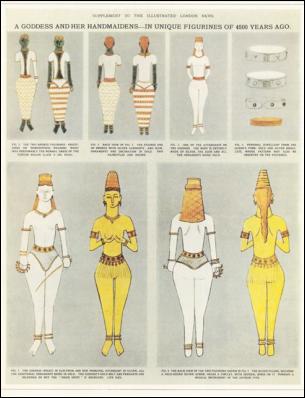
Click for big version

Yortan Goddesses.
Credit: The Illustrated London
News
Mellaart resurfaced from Anna's place with rough sketches of the pieces. He said he'd also seen quasi-professional documentation of the clandestine dig -- orientation of bodies and position of artifacts. And that the tombs were found on Lake Apolyont near Dorak Village, south of the Sea of Marmara.
Excited by the Dorak find - particularly on the heels of Hacilar and Catalhoyuk, hard acts to follow - Mellaart redrew the roughs and rubbings with the assistance of colleagues at BIAA. Mellaart was assistant director of BIAA at the time; his wife Arlette was secretary. The drawings were further dressed by Hydie Lloyd, BIAA director Seton Lloyd's wife, and her friend.
About a dozen years ago I attempted to publish a piece skeptical of the Dorak treasure's existence. My collaborator on the story was Ozgen Acar, a man who through his award-winning journalism (e.g., "Who Stole The Lydian Hoard" and "The Hoard of The Century" -- Connoisseur) helped to rein-in the Munich-based Turkish antiquities mafia. I did most of the interviewing and running around on the Dorak story, wrote it and pitched it. Ozgen provided essential clues and contacts.
I phoned James Mellaart at his home at the time in St. John's Wood and asked him about the treasure. He held to his claim of earlier years that he'd been "set up" - that Anna Papastrati was a plant. Said he'd had an "unsympathetic hearing" before Turkish authorities. And that "nothing was left on the walls [at Catalhoyuk]". Also, that he'd been "trying to get back to Ankara since 1965".
The Turkish government shut down Catalhoyuk several years after the "Dorak Affair". Antiquities had been bleeding from the site through workmen. It resumed excavation only in 1993 -- about 30 years later -- but with Mellaart's role redefined as adviser to the dig. Ian Hodder, then an archaeology professor at the University of Cambridge, took over as project director.
Some of the pieces looted from Catalhoyuk wound up in the hands of Aydin Dikmen, a Konya collector/antiquities dealer. There is a school of thought that Aydin Dikmen was Mellaart's inspiration for Anna Papastrati.
According to Ozgen Acar citing Turkish antiquities authorities, Dikmen had been "collecting" pieces from Turkish villagers beginning in the mid 1950s, when he worked as a technical draftsman in the Konya irrigation office. Dikmen traveled into remote regions where villagers at the time had no sense of what the antiquities were they were finding buried in the fields with their crops. And in case they did, Dikmen had forged paperwork giving him authority to purchase the antiquities on behalf of Turkish museums.
Dikmen would also make a name for himself as a master of fakes. He was more recently arrested in Germany for possession of stolen antiquities, which he'd plastered inside his apartment walls in Munich over the years.
According to Dutch art dealer Michel van Rijn, a former business associate of Dikmen's, "police had expected to find, at most, two or three dozen Byzantine works not 350 pieces worth a cool $60 million." And that the Bavarian police had described it as "the largest mix of stolen art and antiquities recovered since caches of Nazi loot were traced after World War II."

Aydin Dikmen on his knees with St. Andrew. Photo credit: Michel van Rijn
But the statute of limitations ran out on Dikmen's case and after being held by German authorities for a year, he was released in 1998.
Dikmen's role in Catalhoyuk gets buried in the Balter book, even though Kenneth Pearson and Patricia Connor clearly establish Dikmen's connection to the site in their book, The Dorak Affair (Michael Joseph Ltd, 1967). Pearson and Connor say Dikmen's hoard included 1,900 pieces worth 10,000 British Pounds: Lydian gold wreaths, Greek and Roman vases, boxes of coins, several Hacilar pots, a steatopygous (fat-bottomed) nude female fertility goddess, a necklace, obsidian mirror, blades, etc.
Dikmen was arrested in 1966 regarding his Konya antiquities stash. Nevertheless, in September 1966, a piece Dikmen sold through a middle man to the Cleveland Museum in the US made the cover of Art News celebrating the museum's 50th anniversary. "Jonah Cast up by the Whale" was a genuine early Christian marble, one of five originating in Afyon, southern Turkey. Cleveland also bought some of Dikmen's fake Hacilar pieces. And he has sold over the years to Sotheby's as well.
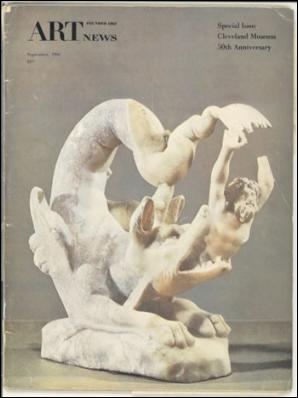
Click for big version
"Jonah Cast up by the Whale" -- Ancient marble sold by Dikmen to Cleveland Museum Photo Credit: Art News
In the summer of 1966, Dikmen gave an interview to Pearson and Conner at his home in Konya, excerpts of which appear in The Dorak Affair:
'This stuff from Catal, you bought that from Mellaart?''No, of course not,' said Dikmen genuinely surprised by the suggestion. 'I bought them from some of his workers.'
'Is that legal?'
Dikmen shrugged. 'It's only illegal if you take the things out of Turkey.'
'But weren't they robbing Mellaart and the Turkish museums?'
'I suppose so,' he said. . . .
'Weren't you involved in some way with the break-up at the end of that season?' we asked Aydin Dikmen.
'Yes, I was,' he said. 'The government woman asked me to come along to the site that day, and she introduced me to Mellaart's workers.'
'You knew him already?'
'Of course. Konya's not very big and I'd got to know him because I was fascinated with the work he was doing. . . . Anyway, the workmen came up one by one to shake hands. Some of them looked very surprised to see me. Whenever I came face to face with a man I had already met, I gave a little nod. There were four altogether. The foreman and three of his assistants. By the next morning, Mellaart told me later, they had vanished.'
In 1991, I visited Dikmen's apartment at #9 Schuzenstrasse in Munich hoping to arrange an interview and ask about Anna Papastrati.
Dikmen's wife "Coco," a Romanian gypsy, buzzed me in. I walked up five flights of stairs and rang the bell. Ozgen stood watch from across the street. We were working on a story about Dikmen for Connoisseur.
I expected Dikmen would be far less congenial than he was during the Konya years. Coco opened the door. She seemed fragile, her face drawn and eyes darting. We shook hands.
I told her I was a reporter on assignment for Connoisseur, an American art magazine, and asked if I could speak with her husband. She said that she did not speak English but managed to convey that Dikmen was in the hospital. There was a medicinal smell coming from inside the dimly-lit flat, but Dikmen was nowhere in sight.
I said I would telephone, and eventually did reach Aydin Dikmen. However, he too claimed not to be fluent in English, although Pearson and Conner said their Konya interview with him was in English.
When I asked James Mellaart about Aydin Dikmen, he would only say, "I don't want to discuss that man. I'd rather not. I don't like people who ruin archaeological sites. I know he had a collection of certain objects which are certainly from excavations. I don't like to go on."
Meanwhile, Connoisseur closed its New York office, so the Dikmen and Mellaart stories the magazine commissioned, Ozgen and I were then free to submit elsewhere. They were rejected by JDF Jones, the Financial Times arts & literary editor, who wrote to me: "The Mellaart article would fall fowl of the British libel laws." Jones later told me by phone that the problem was Mellaart was seen in the UK as "a brilliant scientist". I found an enthused editor at The Guardian, but when he left for a position at The Observer, the paper paid a kill fee.
There was really no other showcase at the time we considered appealing, so we put the Dorak story aside to see how the Catalhoyuk dig would unfold. Ozgen still believes Mellaart may ultimately reveal himself, although he has so far not accomodated the "biographer of Catalhoyuk", Michael Balter.
James Mellaart is almost always described as a genius archaeologist, a man capable of losing himself in discovery and ignoring realities like holes in shoes and the possible motives of a woman wearing the right sort of ancient jewelry.
Long-time Near East expert at the Metropolitan Museum, Oscar White Muscarella ( The Lie Became Great: The Forgery of Ancient Near East Cultures, Styx Publications)[Click here: The Whistle-Blower at the Art Party by Kareem Fahim], who says the plunder of antiquities is about class and the rich, "annihilating the world's history", told me in his office at the Met that, "when with him [Mellaart], there is a presence, a calmness, a sincerity that can affect you." Others simply describe Mellaart as complicated.
Indeed, Mellaart's achievements have been historically pivotal and compared to those of Heinrich Schliemann - the father of field archaeology - who excavated Troy in 1871-3. However, parallels have also been drawn between Mellaart's work and Schliemann's for a lesser distinction, namely the practice of romantic enhancement.
It's believed the photo of Sophie Schliemann wearing the "Jewels of Helen of Troy," for example, did more to make her husband, Heinrich a star than anything else. Kind of like the National Lampoon's " Cosmo pinup" of Henry Kissinger catapulting his career.
Mellaart's supernova was meant to be Dorak. But it resulted in throwing a wet blanket over his scholarship. Although, Mellaart insists Dorak is "fact, not story," there is compelling evidence to the contrary.
For starters, Anna and the Dorak treasure have never been found, although there have been numerous so-called Dorak sightings since 1959. Patricia Connor told me Karl Meyer at the New York Times was "one of the people who used to ring me up and say, 'there's a bit of Dorak cropped up'".
Pearson and Conner similarly came up empty-handed regarding the whereabouts of Dorak and Anna Papastrati in their book, which documented their visit to Turkey in the summer of 1966, following reports by the Turkish press about Mellaart's possible involvement in the Dorak treasure's disappearance. They scoured the Turkish countryside for clues, interviewing collectors/dealers, including Dikmen, and Mellaart and his Turkish wife, Arlette. Some years after publication of the book, they threw away their notes and switched careers, leaving the mystery still unsolved.
Pearson and Connor invited me to their home on the outskirts of London for tea, on my way through London in 1991, but when I got there they would confess that, "it was 24 years ago and our knowledge doesn't go beyond that book." However, Conner did say regarding Mellaart and Dikmen that: "To a greater or lesser extent their lives must have been intertwined. There's a sense . . . if you've got a man who's living and is a collector five, ten miles from the site you're digging, you're bound to at least 'emesh' somehow".
Mellaart seems to have an army of loyalists. I also visited his friend Yanni Petsopoulos while in London. Petsopoulos is an art dealer who shares Mellaart's passion for kilims. He told me at his shop in Notting Hill that "Mellaart was mad for that girl [Papastrati] !"
To learn more about the Dorak drawings, I next attempted to contact former BIAA director Seton Lloyd by phoning his niece Dominique Collon in London. She was curator of West Asiatic art at the British Museum at the time. Collon worked at BIAA in 1964 when Lloyd was director. However, Collon refused to give Lloyd's phone number to me saying only, "My uncle is on holiday in Belgium. He is 89 years old; discussing Dorak would upset him." Seton Lloyd has since died.
David Stronach, a professor of Near East studies at Berkeley, who assisted in redrawing the sketches for The Illustrated London News, hung up on me when I called him in California. He said he was no longer an Anatolian expert. His area was now Iranian archaeology.
But, the Papastrati letter is most problematic. Several months after the supposed encounter with Anna, Mellaart said he received permission from her to publish the sketches:
"Dear James, Here is the letter you want so much. As the owner, I authorise you to publish your drawings of the Dorak objects, which you drew in our house. You always were more interested in these old things than in me! Well, there it is. Good luck, and goodbye. Love, Anna Pappastrati."
The letter was dated "I8/I0/I958" bearing the return address: "Kazim Direk Caddesi no. 2i7, Karsiyaka - Izmir". However, the house in Karsiyaka, Izmir could not be found in local records or in actual foot-searches by anyone.
Michael Balter, who like Pearson and Conner was allowed to see Mellaart's original rubbings of Dorak, fails to address in his book the misspelling of Papastrati's street address in her letter to Jimmie. According to Ozgen Acar, the street was named for a well known governor of Izmir, Kazim Dirik. But Anna spells the name "Direk" - meaning "lampost".
James Mellaart's book, The Goddess from Anatolia, raised more eyebrows when it was published in 1989. The book featured modern kilim designs that paralleled Mellaart's own "sketched reconstructions" of Catalhoyuk frescoes. The book, available only through its publisher in Milan, was received with reservation in professional archaeology circles. Particularly critical of Mellaart's book was Dominique Collon, who cleaned many of the Catalhoyuk wall paintings while at BIAA. [Click here: The Goddess from Anatolia: An Updated View of the Catal Huyuk Controversy. by Marla Mallett.]
Collon wrote an article for Hali (September 1990), a kilim magazine, in which she reported that Mellaart had shown colleagues drawings of 70 unpublished Catalhoyuk landscapes. She noted that Mellaart announced at a lecture in 1987 at London University the existence of other frescoes from the site with a religious theme. The new wall paintings she said Mellaart claimed were reconstructed from tiny fragments which were too numerous and too small to be preserved or photographed and that the tracings on which the reconstructions were based had been destroyed in a fire at Arlette's father's home on the Bosphorus in the mid 70s.
Unfortunately, no one from the dig remembered these fragments, Collon said. She questioned how tracings of small fragments could be reliable. She also argued that Mellart's new murals were vastly different in color and sophistication from the earlier ones, and noted other discrepancies and inconsistencies. Many in the archaeology community felt that the Collon article was hard to overlook.
David French was a co-discoverer of Catalhoyuk with Mellaart, which Mellaart acknowledges in his conversation with Pearson and Conner on the Bosphorus: "It was about four in the afternoon . . . 10 November, 1958 . . . when we arrived at the mound. I had two friends with me. And a whopping great mound it was."
But regarding Mellaart's Dorak treasure, French, a man who was affiliated with BIAA for almost 40 years and most recently served as its director, told me by phone from Ankara that little aside from grave pottery has ever been found that is considered Yortan. That there's really nothing to compare Mellaart's Yortan treasure with.
"I think archaeologically this [view of Yortan] is a little outdated now," French said. "I think that Yortan culture as such doesn't exist; it's a particular type of grave pottery which was common in the northwest of Anatolia. The rest - well, forget."
Dr. Jack Ogden, then a technical analyst of ancient art based in Cambridge, told me: "I find it hard to believe that Mellaart invented the whole thing - surely a bent archaeologist would invent academic, not glitzy objects - interesting texts and terracottas, not gold encrusted daggers. He would be out to impress the scholarly world, not fire the greed of readers of The Illustrated London News."
However, Ogden, who specialized in precious metals, said further that fakers often include pieces such as Dorak's Egyptian gold sheet with hieroglyphics in "so-called find-groups" to date the collection.
The other point is the finding of the Dorak treasure. Ogden asked, as did the Met's Oscar Muscarella, and others: What clandestine excavator in the early part of this century, let alone now, keeps such a detailed record of his finds including orientation of bodies and precise arrangement of finds?
"I don't believe Jimmie is the kind of person who would have made Dorak up. He's not that," Patrician Connor told me during my visit."As I said, he's a very naive man and I think he got embroiled through his naivete."
Ken Pearson also defended Mellaart, "Maybe I'm naive, but I don't believe Mellaart could have put together a scam of that grandeur."
But the Papastrati letter is troubling for another reason. Comparing Mellaart's other correspondence from BIAA - I've seen half a dozen of the Institute's letters from that period - those typed by Arlette Mellaart have identical style features to the Anna letter, such as the use of Roman capital "I" instead of "1" in the date.
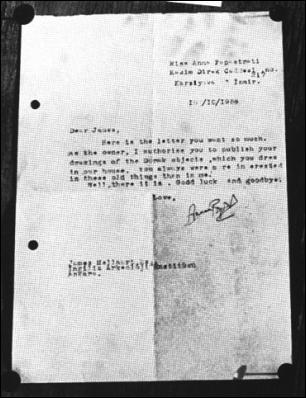
Click for big version
Anna Papastrati Letter--Photo Credit Horizon Magazine
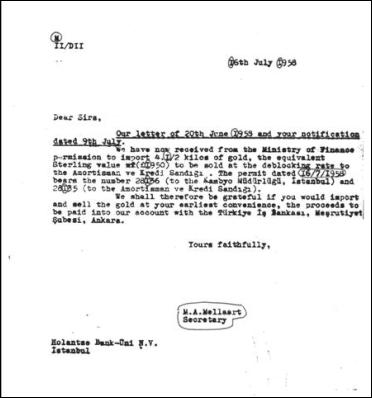
Click for big
version
Mellaart Letter To The Bank--
Credit: British Institute Of
Archaeology--Ankara
Letter from Anna - "I8/I0/I958"; letter from Mellaart to the bank - "I6/7/I958". Most people would type lower case "ell" for the number "one" if there were no number one on the keyboard.
A spokesperson for the Department of English at Oxford told me that outside Oxford/Cambridge scholarly circles dating a letter with Roman numerals is just not done and was not done, even 40 years ago.
Evidence indicates James Mellaart was the author of the letter, not Anna Papastrati, and that Mellaart's wife Arlette, who was secretary at BIAA, assisted with the letter's typing.
And the Dorak treasure? Since the letter from Anna is the only proof the treasure exists and it was typed on the British Institute of Archaeology -- Ankara's Remington manual typewriter, it is almost a fait accompli there is no Dorak treasure.
The remaining question, which only James Mellaart can answer, is: Why?
Suzan
Mazur's stories on art and antiquities have been published
in The Economist, Financial Times, Connoisseur, Archaeology
and Newsday. Some of her other reports have appeared on
PBS, CBC and MBC. She has been a guest on McLaughlin,
Charlie Rose and various Fox television news programs.
Email: sznmzr@aol.com


 Binoy Kampmark: Junk Science And Bad Policing - The Homicide Prediction Project
Binoy Kampmark: Junk Science And Bad Policing - The Homicide Prediction Project Keith Rankin: Rational Expectations, Intelligence, And War
Keith Rankin: Rational Expectations, Intelligence, And War Peter Dunne: Dunne's Weekly - Is Andrew Little Wellington's Mayor-In-Waiting?
Peter Dunne: Dunne's Weekly - Is Andrew Little Wellington's Mayor-In-Waiting? Gordon Campbell: On Peter Dutton’s Fading Election Prospects.
Gordon Campbell: On Peter Dutton’s Fading Election Prospects. Binoy Kampmark: Withdrawal Symptoms - Hungary, Europe And The International Criminal Court
Binoy Kampmark: Withdrawal Symptoms - Hungary, Europe And The International Criminal Court Martin LeFevre - Meditations: No Silver Lining, Just An Opening
Martin LeFevre - Meditations: No Silver Lining, Just An Opening